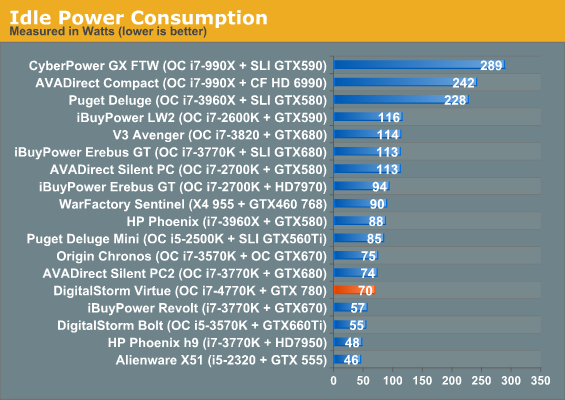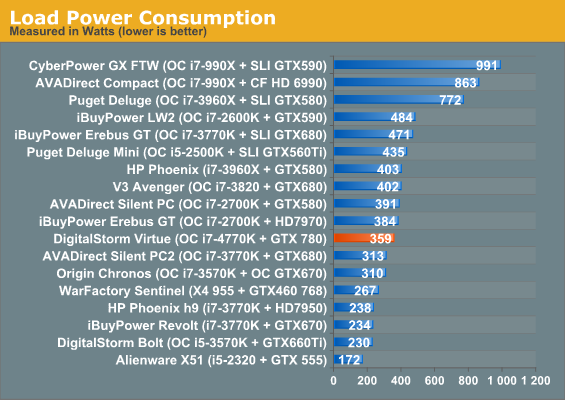Haswell and GK110 vs. Ivy and GK104: DigitalStorm Virtue System Review
by Dustin Sklavos on June 23, 2013 12:00 PM ESTBuild Quality
It's not entirely fair to DigitalStorm not to mention the generally excellent job they've done with the build quality of the Virtue. One of the ways a boutique can distinguish itself is in its component selection, and the stock component choices of the Virtue line are solid across the board.
Starting with the chassis selection, I'm actually a pretty big fan of the Corsair Obsidian 350D and I'm happy to see it being employed in a high performance system. Interestingly, DigitalStorm is also using Corsair's H100i to cool the CPU, but they're not employing Corsair Link software to control fan speed despite the system being wired to use it. Instead, the fans on the H100i (oriented beneath the radiator to pull in air from the top of the enclosure and then cycle it out of the rear exhaust) run at a fixed fan speed. I personally find variable fan speed to be distracting; I'd just as soon the whole system run silent all the time, end of discussion. DigitalStorm's choice here works for me.
.jpg)
The 350D also does an excellent job of showing off NVIDIA's reference cooler for the GeForce GTX 780, complete with the subtly glowing "GeForce GTX" logo. That's plugged into an ASUS Z87 Gryphon motherboard, and the system drive is a healthy 120GB Corsair Neutron GTX featuring an LAMD controller. Given all the Corsair kit in the Virtue, though, I'm actually surprised the memory is A-Data.
Where I'd be tempted to shake down DigitalStorm is in using a single stable voltage for overclocking the i7-4770K, but without more experience with Haswell and the quirks of its VRM I can't say if that's worth caring about or not. With the first generation chips (Nehalem, Clarksfield, Gulftown), this was a huge issue, but Sandy and Ivy were less problematic and it looks like Haswell is even less so. I do want to point out that DigitalStorm has traditionally been more aggressive about their CPU voltages than I'd like, but the i7-4770K's 1.28V is actually pretty common and totally reasonable.
Noise and Heat
Demonstrating a healthy amount of balance in their design, the Virtue isn't especially silent but is generally a touch quieter than enthusiast gaming desktops tend to be. Idle noise is around ~33dB, and since the CPU and chassis fans run at a fixed speed, the GeForce GTX 780 is really the only component that spins up or down. Unfortunately, while the 350D is an excellent case for liquid cooling, it does suffer slightly from Corsair's perpetual issues with middling air cooling performance.

Thermals on the GTX 780 are pretty par for the course, but it can jack noise levels up a couple of dB under sustained load. Meanwhile, the i7-4770K is really about where it needs to be. A more adventurous user might be able to eke a little more performance out of it with a little more juice, but I'd hesitate to push the H100i that much harder, especially without bumping the fan speeds up to a potentially uncomfortable volume.
Power Consumption
So how much power does a modern high end gaming system pull from the wall? The last couple of generations from Intel, NVIDIA, and AMD (Bulldozer/Piledriver notwithstanding) have all done an admirable job of continually reducing idle and load power consumption alike, so the DigitalStorm Virtue stands to benefit from those advances.


And it does. While neither one is abnormally spectacular, they're both totally reasonable. I'm not convinced DigitalStorm couldn't shave 10W or so off the idle power, but load power is where it ought to be.


_thumb.jpg)
_thumb.jpg)
_thumb.jpg)
_thumb.jpg)
_thumb.jpg)
_thumb.jpg)








70 Comments
View All Comments
Sabresiberian - Sunday, June 23, 2013 - link
My guess is that the Gryphon was getting expensive already, and Asus decided to use the lower-priced sound chip to help keep the retail price down. I mean it's already $175 in the U.S. (without the armor kit, which is another $45, heh). I don't mind because I'm not going to use the on-board sound solution anyway. (Yeah I bought a Gryphon, cause it had all the features I wanted, 5-year warranty, and I like its looks, and I bought the armor kit cause I like its looks and for the protection of any unused slots. Haven't assembled it yet as I'm waiting for the armor kit.)airmantharp - Monday, June 24, 2013 - link
I'm wondering if it matters- all Realtek codecs in the last five or so years have had decent specs and middling performance; but it doesn't take much to make them work. Good op-amps are a start, and we're seeing those on various boards.And that would be important for an mATX build; it's begging for a second GPU (why the hell else would it have twice the PSU it needs...), which would negate the use of an excellent SoundBlaster Z.
Subyman - Sunday, June 23, 2013 - link
I'm wondering why they put a 1050W PSU in a system with an ~80W CPU and ~250W GPU.JimmiG - Sunday, June 23, 2013 - link
Marketing..Anyway, 4.4 GHz is probably about as high as you want to go as boutique PC manufacturer, unless you want amass quite a collection of 4770K's that didn't make it to your target overclocked speed.
kuraegomon - Sunday, June 23, 2013 - link
Upgradability, specifically SLI, and further overclocking. Add a second 780 (admittedly a tight fit in that case), and go for broke on the overclocking CPU, GPUs and RAM, and you could end up in the 700-800 W range. For maximum PSU life, running at least 20% under maximum rating is about right.JimmiG - Sunday, June 23, 2013 - link
If the system consumes 800W, that also means it would put out 800W of heat, which would be impossible to manage with that case. Besides, it comes with a m-ATX board which means those GTX 780's would be sitting right up against each other. It would be toasty, to say the least. PSU life would be the least of my concerns.Dustin Sklavos - Sunday, June 23, 2013 - link
Consuming 800W of power does not mean producing 800W of heat. Heat generated in a computer is "waste heat," it's heat produced by energy leakage.If you look at the board, too, you'll notice a second 780 would actually be installed in the bottommost slot. That means there would be one slot of space between the two 780s, which is typical of almost any build.
Death666Angel - Sunday, June 23, 2013 - link
Electricity is energy and heat is energy and energy cannot be created or destroyed, it can only be transformed. Unless the energy the computer pulls from the socket gets transformed into electro magnetic waves or mechanical energy, it gets transformed to heat. Which is what happens to over 99% of the energy input into the PC.Not sure if you refer to something else.
jtd871 - Sunday, June 23, 2013 - link
Dustin, the heat in a computer is a reflection of *total* power draw. All that energy, waste or not, eventually turns into heat. Thus at idle, this system generates ~70W; at load, ~360W.Meaker10 - Sunday, June 23, 2013 - link
So what useful work in energy terms do we get out? Mechanical lift? Come on dustin I ex0ect more from an anandtech reviewer knowing the fundamentals :/